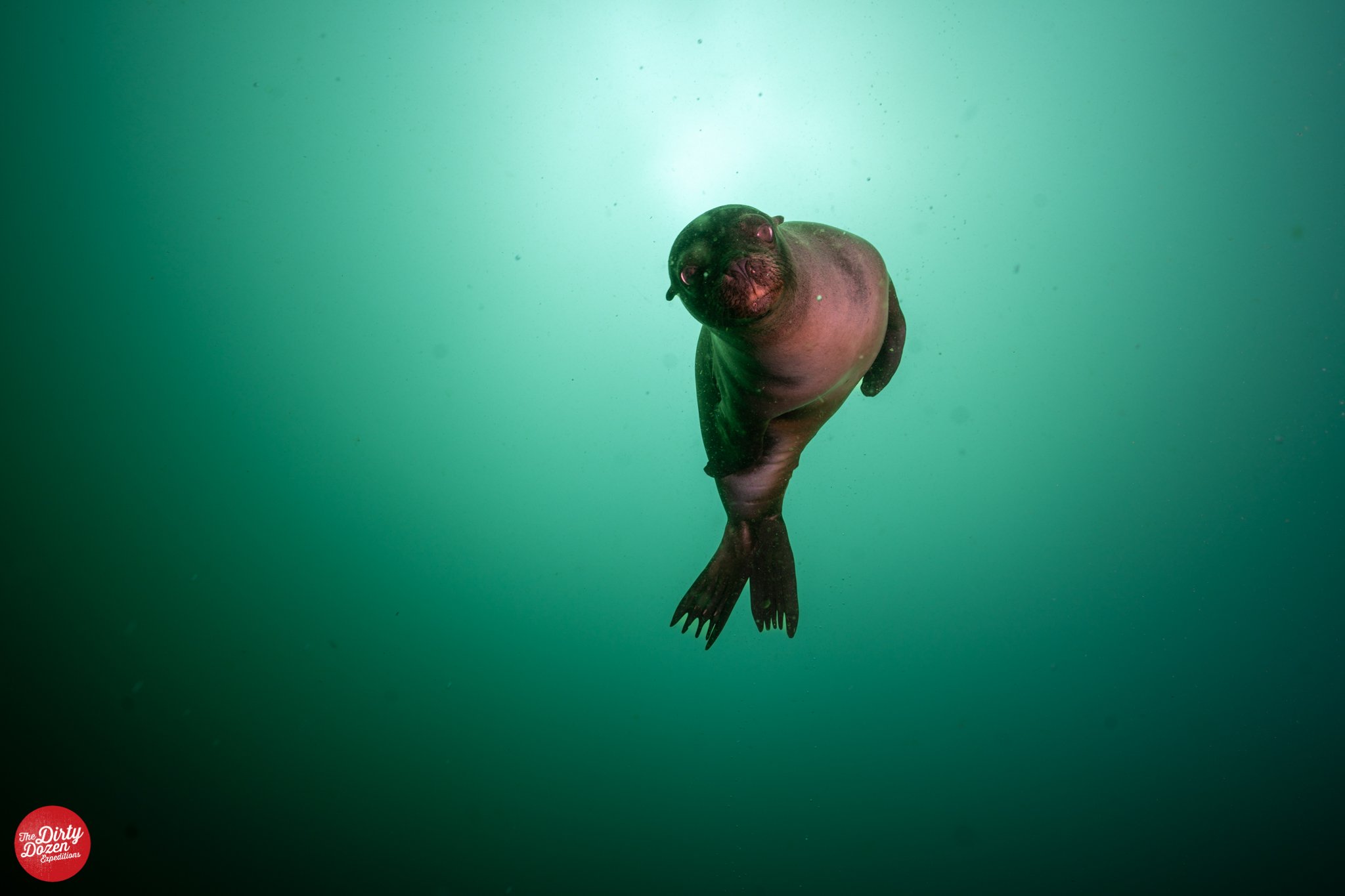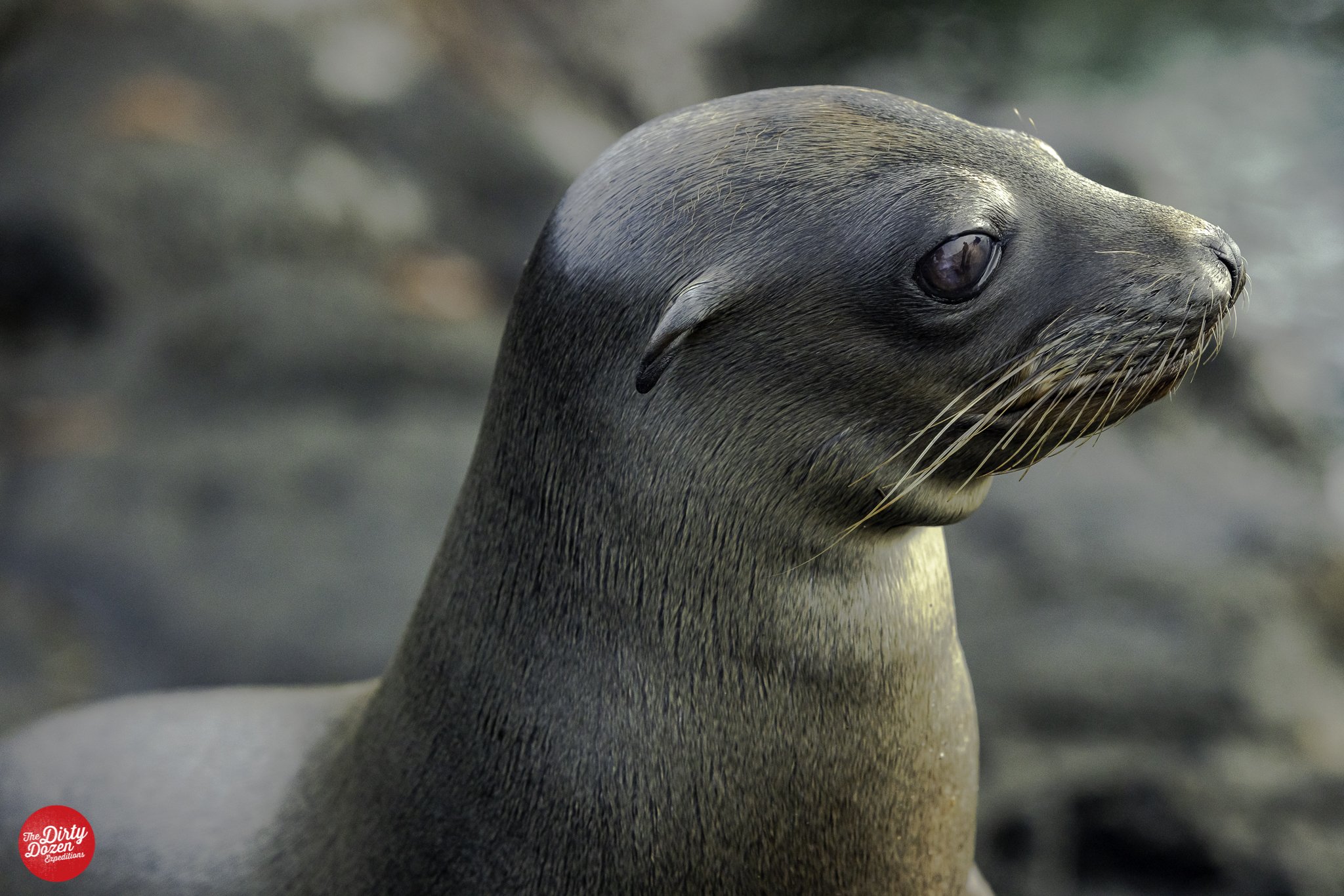Straddling the equator and spread out over 45,000 sq km (17,000 sq miles) the Galapagos Archipelago is home to some of the planet’s most remote dive sites and best big animal diving.
When we think of the Galapagos, the first things to come to mind are probably iguanas, sharks, and Charles Darwin. But the islands have a rich history and there are plenty of interesting tales originating from our earth’s closest approximation to Jurassic Park.
Did you know that in 1807 an Irish named sailor Patrick Watkins became the first known inhabitant of the Galapagos Islands? Abandoned on Floreana, Patrick was left to fend for himself, growing vegetables and hunting so he could sell his goods to passing whalers and boat crews in exchange for rum and cash.
Imagine what he saw as he sat on Floreana alone.
Giant tortoises, hundreds of years old, swarms of sharks in the waters surrounding him, marine iguana grazing on algae and fur seals lining the rocky coves. While away from the coast, the land is blanketed in a thick, impenetrable forest and to top it all off, the island is perched on an active volcanic plate.
Pat was on a true Jurassic adventure, with the dinosaurs to prove it.
Nowadays, pulling into Pat’s landing on Floreana, little has changed. The wildlife remains as intriguing as it was when Darwin first started describing it in the mid 18th century and the islands retain their wild, final frontier feel.
Diving conditions and environmental factors
Diving in the Galapagos is rewarding but occasionally demanding, even for very experienced divers. To make sure you enjoy your trip, rebreather divers should hold training at a minimum of MOD 1 and have completed at least 30 or more dives. It is preferable if you have experience with strong currents and low visibility.
At many Galapagos dive sites, the currents run on the strong side. Because of these currents and the huge amount of nutrients in the water, the visibility may be low at times.
But every cloud has a silver lining and the environmental factors that make diving here hard at times are the same factors that make the Galapagos one of the world’s premier locations to dive with pelagic life. Underwater, a diverse cast of creatures from sunfish and seals to iguanas and everything else in between can be seen.
Water Temperature and Exposure Suits
Divers are often surprised that the water temperature in the Galapagos is cooler than they expected. Despite the archipelago’s location at the equator, cool currents keep temperatures closer to moderate than warm.
Divers can expect water temperatures that range from 12°C to 26°C (53-78°F).
Thermoclines are common. To combat the sharp changes in temperature, divers in the Galapagos should bring exposure protection that is suitable for the cooler depths. We recommend a drysuit with light and thick undergarments so you can adjust your thermal protection during the swinging temperatures during the trip. You should also pack your gloves as these are useful for support when a strong current is running. A reef hook is also recommended.
If you feel the cold, it’s best to pack an extra vest, hood, or shortie for use with your normal suit. Aboard our vessel, we have 5 and 7 mm full wetsuits available for rent, which you can use in conjunction with your own gear. Boots and open heel fins are recommended.
CCR Dive sites in the galapagos
San Cristóbal Island
After boarding at San Cristóbal, all diving guests onboard Galapagos Master will carry out a check-out dive after assembling their units in the late afternoon to make sure everything is 100% before we depart. The dive is carried out in a sheltered bay in an excellent shallow spot.
Photo by Dallas Simpson
Santa Cruz Island
Punta Carrion – This boulder strewn reef provides a superb introduction to some of the larger pelagics we expect to see in the Galapagos, including white tip reef sharks but also the occasional hammerhead and Galapagos shark. Sea lions are ever-present and there is the opportunity for some macro critter spotting with sightings of neon nudibranchs.
North Seymour – Situated off the northern tip of Baltra Island, this site provides a stunning drift with sightings of white tip reef sharks, turtles, eagle rays and moray eels.
Mosquera - Located in between the islands of Baltra and North Seymour, this white sandy islet is not only home to a sea lion colony, but also supports a myriad of marine life; from manta rays and bonitos to Peruvian grunts and fields of garden eels. Occasionally, schools of hammerhead sharks may be seen here.
Photo by Dallas Simpson
Wolf Island
Named after the German geologist, Theodor Wolf, this extinct volcano reaches 253m (780ft) above sea level and lies some 160km (100 miles) northwest of Isabela Island. Land visits are not permitted however bird life, including red-footed boobies and vampire finch, may be spotted from the boat.
For our dives here we choose from a selection of reefs and walls, most having typically medium to strong currents where the use of gloves is advised. Schooling pelagics are the main draw with sightings of hammerheads, white tips, and Galapagos sharks at each site. Whale sharks may also be seen here. Divers should also be on the lookout for red-lipped batfish, barracudas, moray eels, and dolphins!
El Durrumbe (the Landslide)
La Ventana (the Window) - shallow lagoon leads down to a pinnacle and then out along the reef wall
La Banana - Wall dive with strong currents.
Punta Shark Bay - Reef dive with typically good visibility, however care must be taken in the shallow water where waves crash up against the reef.
Anchorage - The reef, with typically very mild current, provides a good spot for a sunset dive.
Hat Island - another spot with milder current, this reef provides sightings of numerous colourful fish species.
Pinaculos (The Pinnacle) - known for its strong currents and speedy drift along the reef at an average depth of 20m (70ft), the site is excellent for shark spotting and the many cracks & crevices in the wall provide extra interest.
Darwin Island
This extinct volcano reaching 165m (490ft) above sea level was named in honor of naturalist Charles Darwin. It is amongst the smallest islands within the Galapagos Archipelago and like Wolf Island, no land visits are permitted.
Perhaps the most famed dive site is “Darwin’s Arch” which now are “Darwin’s Pinnacles” which provides an amazing drift dive along the wall at an average depth of just 9m. Medium to strong currents is to be expected but bring with them hammerheads, black tips, silky and Galapagos sharks – and in large numbers!
Schools of jacks are a common sight, along with turtles, angelfish, and moray eels. Occasional sightings of tiger sharks, manta rays and bottlenose dolphins make for a thrilling time spent here. Whale sharks may also be seen between May and November.
Photo by Perry Brandes
Fernandina Island
Cape Douglas - Situated on the northwest point of Fernandina Island, this wall dive, with an average depth of 20m (70ft), offers something truly spectacular and is now famed for the feeding marine iguanas that congregate here along with sea lions, fur seals and speedy penguins!
Photo by Jonathan Saenz
Isabela Island
Punta Vicente Roca - Alternatively known as “The Ice Box”, due to its chilling thermoclines, this point off the northwest coast of Isabela Island offers a wall drift dive, along which mola mola can be spotted. The occasional Port Jackson shark may also be seen as well as the endemic Camotillo (White-spotted sand bass). Yet Punta Vicente Roca is not just for the larger marine life but is also a fantastic place to spot Pacific seahorses, frogfish, octopus, nudibranchs, flatworms and a variety of sponges. We stick to a maximum depth of 40m (130ft) with an average of 18m (60ft) while enjoying some milder currents!
Punta Albermale - Drifting along this wall on the north of Isabela Island, we stay at an average depth of 25m (85ft) to see manta rays, hammerheads, turtles, schools of barracuda and tuna.
Roca Redonda - This underwater volcano, with its bubbling streams of natural gas (fumaroles) plays home to schools hammerheads sharks and barracuda. Other commonly sighted marine life include Galapagos sharks which typically come close to divers during safety stops, as well as manta rays, silky sharks and some beautiful green/blue nudibranchs. With typically strong, changeable currents and some down currents, the diving here is challenging, though with an average depth of 18m (60ft).
Cabo Marshall - The craggy volcanic walls are covered with black coral bushes and the sheer variety of marine life is astounding. Sightings of manta, mobula and cownose rays are to be expected during the warm season (November – May). Meanwhile, shark varieties include scalloped hammerhead, Galapagos and white tips. Schools of chevron barracuda and black striped salema are regular visitors along with yellowfin tuna and big eye jacks. And let’s not forget the sea lions and turtles!
Tagos Cove - On the west side of Isabela Island, opposite Fernandina Island, this shallow reef is an excellent late afternoon dive, where we have the opportunity to find seahorses, frogfish and long nosed hawk fish.
Santiago Island
Cousin’s Rock - One of the most photographically productive dives of the region, Cousin’s Rock is formed of coral covered rock and lava flow. Sea fans, hydroid bushes, red sponges and small hard corals encrust ledges and overhangs, sheltering hawkfish, nudibranchs, frogfish and seahorses. Plenty of larger visitors are also seen here, including giant manta and mobula rays, spotted eagle rays and hammerhead sharks. The wall drops beyond 30m (100ft) but rises up shallow to just 3m (10ft) providing an ideal spot to end your dive playing with the sea lions.
Each Dirty Dozen CCR Only itinerary is different and before each trip we submit a proposal for the dive sites which is approved by the marine park.





















